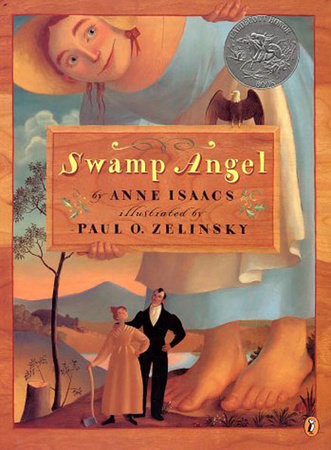|
Isaacs, Anne. Swamp Angel. Illus. Paul O. Zelinsky. New York: Dutton Children's Books, 1994.
Swamp Angel follows the tale of a larger-than-life, Tennessee-born woodswoman, who earns her name from saving a group of pioneers stranded in a swamp. She can hold her own in the wilderness and becomes the only female contender in a competition to kill the Thundering Tarnation, an impressive bear that terrorizes the settlers. Utilizing her strength and intellect, she arises the victor. Swamp Angel gives Paul Bunyan a run for his money with the stature of her accomplishments, including reigning a tornado and killing a giant bear. Isaacs creates a lesson in hyperbole with the feats and adventures attributed to Swamp Angel; however, she shows readers that female protagonists do not have to be princesses but can be strong, resourceful, and outdoorsy heroines. In addition, to add to the cultural atmosphere of the Tennessee backwoods, Isaacs incorporates words such as “tarnation,” “varmint,” and “twister” to recreate a southern dialect. Most importantly, she captures the reader with her humor, especially in relating the debacles of the buccaneers and the wittiness of Swamp Angel’s replies to the stereotypical male comments made toward her. When the men taunt Swamp Angel about whether she should be home baking a pie instead of hunting a bear, she replies, “I aim to… a bear pie.” Swamp Angel exemplifies that women can be what they want, that they can defy stereotypes, and that they can hold their own in a male-driven world. Paul O. Zelinsky’s art is perfect for Isaacs’ text. The landscapes are reminiscent of the Hudson River School, which depicted such rugged and uncivilized landscapes. Additionally, the more subdued colors, focusing on neutrals, add to the pioneering setting. Moreover, the faux wooden frames give the art a rustic appearance, appropriate for the tale’s time period. Zelinsky also adopts the comedy found in Isaacs’ text; the family portrait on the first page, in particular, is absurd, presenting Swamp Angel as an adult-sized infant, with a giant, balloon-shaped, bobble head. Lastly, the illustrations allow the reader to better visualize the origins of landmarks, such as the Shortgrass Prairie, which is, supposedly, comprised of the colossal bear pelt, as well as the bear’s indention in the stars. Reviews: "Swamp Angel (Book)." Book Links 13.5 (2004): 27. Library, Information Science & Technology Abstracts with Full Text. Web. 13 Feb. 2013. "Zelinsky's Caldecott Honor-winning art perfectly complements Isaacs' delightfully witty text, chock-full of tall-tale phrases." ALA's 1995 "Best" lists: Notable children's books, 1995: All ages. Burns, Mary M. "Swamp Angel." Horn Book Magazine 71.2 (1995): 184. Library, Information Science & Technology Abstracts with Full Text. Web. 13 Feb. 2013. "Move over, Paul Bunyan, you are about to meet Swamp Angel, an original creation in the tall-tale tradition whose exploits are guaranteed to amaze and amuse a wide swath of readers." Starred book review in Booklist. Connections: There is a video version of Swamp Angel, which could be used in conjunction with the book. Compare and contrast it with tall tales that have male protagonists or with tales from other cultures that have female protagonists; for example, Dona Flor may be a good read with Swamp Angel. Read other tales by Isaacs or examine other artwork by Zelinsky.
1 Comment
|
|

